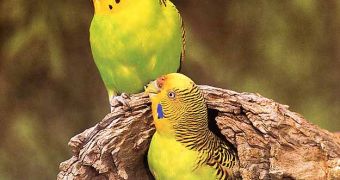The small Australian parrot called budgerigar (Melopsittacus undulatus) has turned into the most widespread cage bird worldwide. Here are some rules of dealing with these cute birds.
1. Remember that a budgerigar lives up to 12 years, a period when you have to take care of it. Remember that a wounded or sick bird requires a visit to the veterinarian, which means time and money. The budgerigar attaches strongly to its owner and will experience sadness if separated forever.
When you buy a budgerigar, the bird must be young (5-8 weeks old); at this stage of life, the individual is tamed and adapts easier to a new environment. Make sure you acquire the bird from a pet shop, a trustful keeper, friends or known people who have budgerigar offspring.
A healthy budgerigar has soft and shiny feathers, the eyes and nostrils do not secrete fluids, the feet and digits are straight and clean. The bird must be vivid, clean its plumage and play with the rest of the birds in the cage.
What's the difference between an adult and a young? The young has large black eyes, like buttons; the adult has the white iris clearly visible. In young birds, the feathers have undulated stripes stretching all over the head to their beak; in adults, the top of the head and the throat have just one color, without stripes. Young birds have a darker beak.
2. For the budgerigar, the cage is a secure refuge where it sleeps and eats. The larger the cage, the happier the bird. The ideal cage is 1 m (3.3 ft) long, 50 cm (1.6 ft) wide and 80 cm (2.6 ft) tall. The bars on the lateral sides must be horizontal, because budgerigars enjoy climbing them. The distance between the bars must not be larger than 1.5 cm (0.6 in), otherwise the birds can sneak out. The door of the cage must be large enough so that your hand gets trough it. There must be no more than 4 perches.
3. The budgerigar has a keen hearing and must be accustomed gradually with the sound of a TV set. The bird might get frightened by the sound of shootings in a movie, for example, that's why you should keep the volume lower and the bird as far as possible from the screen.
4. If you place the cage of the budgerigar into the kids' room, take into account that the birds get awake as soon as the light rises, and they start chirping and moving inside their cage. The noise may wake the children up. You should also observe if the bird feels alone in the kids' room. In the morning, children are at school, and in the afternoon they may play outside. And the budgerigars love to be the center of your attention. They are social birds that require a lot of activity.
5. The budgerigars do not speak. Some may mimic the sound of the bell or a song often heard, but most individuals do not mimic anything. Anyway, the budgerigars have many other skills. For example, they are very playful and learn to play with human toys.
6. When baptizing you budgerigar, its name must contain vowels, which sound clearer and more intimate for budgerigars, which have high pitch voices.
7. Budgerigars love soaking their feathers, that's why they must have special water bowls for this "operation". They also enjoy chewing paper pieces. To be sure they won't attack your books and notebooks, leave pieces of white paper near their cages.

 14 DAY TRIAL //
14 DAY TRIAL // 
